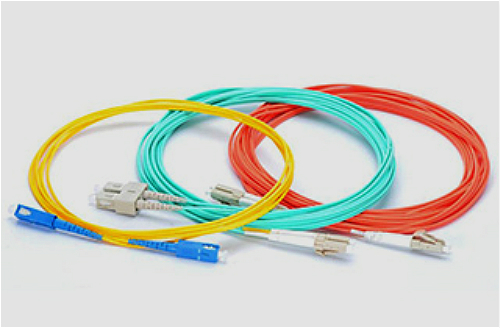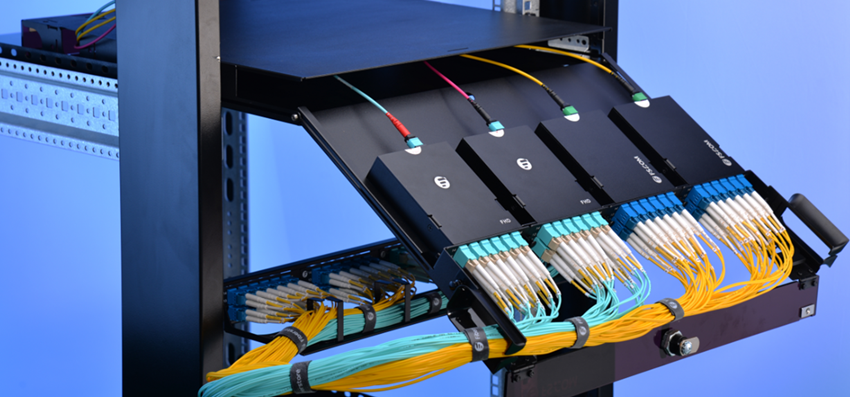Size and weight factors are always needed to be taken into consideration when preparing for a cable plant installation. Fiber optic cables are now running existing conduits or raceways that are partially or almost completely filled with copper cable. This is another area where small fiber optic cable has advantages over copper cable. In this article, we will do a comparison and try to determine the reduced-size and weight advantages of fiber optic cable that over copper cable.
Advantages of Fiber Optic Cable
As we already know, a coated optical fiber is typically 250um in diameter. We learn that fiber optic ribbon cable sandwich up to 12 coated optical fibers between two layers of Mylar tape. Twelve of these ribbons stacked on top of each other form a cube roughly 3mm by 3mm. This cube can be placed inside a buffer and surrounded by a strength member and jacket to form a cable. The overall diameter of this cable would be only slightly larger than an RG6 coaxial cable or a bundle of four Category 5e cable.
So how large would a copper cable have to be to offer the same performance as the 144 optical fiber ribbon cable? That would depend on transmission distance and the optical fiber data rate. Take Category 5E cable as an example, let’s place a bundle of Category 5e cables up against the 144 optical fiber ribbon cable operating at a modest 2.5Gbps data rate over a distance of just 100m.
A Cat5e cable contains four conductor pairs and as defined in ANSI/TIA-568-B.2 is 0.25” in diameter. Each pair is capable of a 100MHz transmission over 100m. 100MHz transmission carries 200 million symbols per second. If each symbol is a bit, the 100MHz Category 5e cable is capable of a 200Mbps transmission rate. When the performance of each pair is combined, a single Category 5 cable is capable of an 800Mbps transmission rate over a distance of 100m
Now let’s see how many Category 5e cables will be required to provide the same performance as the 144 optical fiber ribbon cable. The 144 optical fiber ribbon cable has a combined data transmission rate of 360Gbps. When we divide 360Gbps by 800Mbps, we see that 450 Category 5e cables are required to equal the performance of this modest fiber-optic system.
When 450 Category 5e cables are bundled together, they are roughly 5.3 inches in diameter. As noted earlier in this chapter, the 144 optical fiber ribbon cable is approximately the size of four Category 5e cables bundled together. The Category 5e bundle thus has a volume of roughly 112.5 times greater than the 144 optical fiber ribbon cable. In other words, Category 5e bundles need 112.5 times more space in the conduit than the 144 optical fiber ribbon cable.
This comparison we just made is very conservative. This distance we used was kept very short and the transmission rate for the optical fiber was kept low. We can get even a better appreciation for the cable size reduction fiber optic cable offers if we increase the transmission distance and the data rate.
In this comparison, let’s increase the transmission distance to 1,000m and the data transmission rate to 10Gbps. The bandwidth of a copper cable decreases as distance increases, just as with fiber-optic cables. Because we have increased the transmission distance by a factor of 10, it’s fair to say that the Category 5e cable bandwidth will decrease by a factor of 10 over 1000m.
With a reduction in bandwidth by a factor of 10, we will need ten times more Category 5e cables to equal the old 2.5Gbps performance. In other words, we need 4,500 Category 5e cables bundled together. In this comparison, however, the bandwidth has been increased from 2.5Gbp to 10Gbps. This means we have to quadruple the number of Category 5e cables to meet the ban width requirement. We now need 18,000 Category 5e cables bundled together. Imagine how many cables we would need if the transmission distance increased to 80,000m. We would need whopping 1,440,000 Category 5e cables bundled together.
These comparisons vividly illustrate the size advantages of fiber optic cable that has over copper per cables. The advantage becomes even more apparent as distances increase. The enormous capacity of such as small cable is exactly what is needed to install high-bandwidth systems in buildings where the conduits and raceways are almost fully populated with copper cables.
Now we have calculated the size advantages of fiber optic cable over Cat5e cable. Let’s look at the weight advantages of fiber optic cable. It is pretty easy to see that thousands, tens of thousands, or millions of Cat5e cable bundled together will outweigh a ribbon fiber optic cable roughly one half of an inch in diameter. It’s difficult to state exactly how much less a fiber optic cable would weigh than a copper cable performing the same job – these are just too many variables in transmission distance and data rate. However, it’s not difficult to imagine the weight savings that fiber-optic cables offer over copper cables. These weight savings are being employed in commercial aircraft, military aircraft, and the automotive industries, just to mention a few.
Conclusion
From the above, we have learned the size and weight advantages of fibre optic cable. FS, a reliable provider of networking equipment, offers a comprehensive line of fiber optic cables and Ethernet cables. Any queation about cabling, please contact us via sales@fs.com.
Related Articles:
The Advantages and Disadvantages of Optical Fiber
FS Fiber Optic Cable Types


